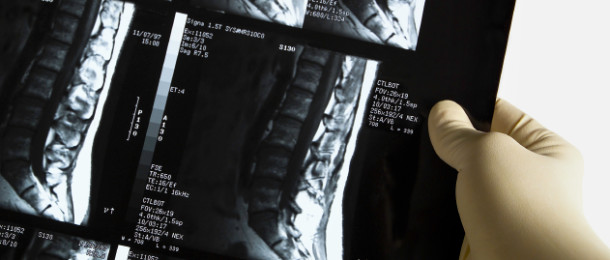Overcoming Scoliosis

Although the upper spinal column has a degree of roundness and the lower portion of the spine appears to sway when viewed from the side, it should be a straight vertical line when observed from the rear. Scoliosis is a lateral, or sideways, curvature of your spine. The condition most often occurs during a growth spurt just before the onset of puberty. Although the cause of many cases of scoliosis is unknown, it can be the result of medical conditions like cerebral palsy and muscular dystrophy as well as physical trauma. The medical condition also tends to run in families. Girls have a higher risk of developing the condition.
What is Scoliosis?
Most cases are mild, but the disorder can worsen over time. Severe scoliosis can be debilitating. A severe curvature of the spine can reduce the amount of space within the chest cavity. As a result, the lungs may not function properly. The curvature may also cause balance problems due to uneven hips or uneven leg lengths. As the condition progresses, the spine may rotate or twist resulting in a protruding rib or shoulder blade.
Treatment Options
A doctor should closely monitor the individual to determine whether the curvature is worsening. While mild cases do not require treatment, complex curvatures of the spine may require physical therapy, chiropractic care or a brace. Particularly severe cases may require surgery. Adults with the disorder may experience chronic back pain. Physical therapy techniques have been developed to offset the side effects of scoliosis and help you to breathe better. Therapy can also improve the shape and appearance of your body chiropractic care may be effective in treating acute short-term pain.
In severe cases, wearing a brace is the recommended course of treatment to prevent further curvature of the spine. Contoured to conform to the patient’s body, the device fits underneath the arms and around the hips, lower back and rib cage. The close-fitting brace is worn underneath the clothing and typically does not interfere with daily activities. The brace should be worn day and night because the number of hours that it is worn increases its effectiveness. Children can remove the brace to participate in sports if required. Wearing the brace is discontinued after the spinal column stops growing.
While bracing can halt the progression of the curvature, it may only provide temporary correction of the condition. The scoliosis may assume its original magnitude or worsen when the brace is removed. If the curvature exceeds 45 degrees, the Scoliosis Research Society generally recommends surgery as the prescribed course of treatment. If the curve is allowed to exceed 70 degrees, the disorder distorts the individual’s normal posture.
Spinal fusion is the most common type of surgery. During the procedure, surgeons will connect two or more vertebrae together with pieces of bone or bone-like material. Metal rods, wires and screws are used to hold the spinal column in place until the vertebrae fuse together. In children, an adjustable rod is used. The rod will be lengthened every few months based on how fast the child is growing.
If you or your child are experiencing back pain or any of the other symptoms of scoliosis, you should schedule an appointment with a medical professional. Early diagnosis and treatment increases the chance of a more positive outcome.
If you are reading this on any other blog than Comprehensive Pain Management Center or via my RSS Feed, it is stolen content without credit. You can find us on Twitter via @CompPainMgmt. Come and visit our blog at http://www.compainmc.com/blog/.
Complementary Treatments for Chronic Pain

Do you have chronic pain? If so, then you are not alone. According to the National Institute of Health, almost 50 million American adults have chronic pain. Chronic pain can be quite debilitating and sap both your energy and well-being. Luckily there are complementary treatments for chronic pain in order to limit the amount of pain felt.
What can you do to manage chronic pain? There are a number of effective treatment. When used with medications and other interventions for pain, complementary treatments are highly effective. Complementary treatments for chronic pain are therapies that are used in conjunction with conventional treatments. Complementary therapies include a wide variety of treatments, such as vitamin supplements, yoga, relaxation, exercise and many others.
In the past ten years, there has been strong research evidence for the benefits of alternative therapies. These treatments are an excellent adjunct to traditional medications and interventions. They can help you lead a happier and fuller life. Combining complementary therapies may allow you to reduce the dose of your pain medications or, in some cases, alleviate your pain. Alternative therapies also provide you with the ability to actively assist with your pain management. Here are some of the most effective complementary treatments for pain.
Cognitive Behavioral Therapy
Cognitive behavioral therapy helps individuals identify and change thoughts and behaviors that contribute to poor pain management. By changing negative thoughts and behaviors, people can alter their awareness of pain and develop more adaptive coping skills to manage pain. The brain perceives pain, so addressing thoughts and behaviors related to pain can the way you view it.
Acupuncture
Acupuncture can be used to treat more than 30 diseases, including pain, according to the World Health Organization. Acupuncture was used by Sixteenth Century Chinese doctors, who believed that disease and sickness is due to an imbalance of energy in the body. Acupuncture involves using stainless steel needles to stimulate the body’s major energy-carrying channels. This helps to correct imbalances in the body. Acupuncture is believed to alleviate pain by increasing the release of endorphins, which are chemicals that block pain. Endorphins are part of a system that blocks the message of pain from being delivered to the brain.
Chiropractic Treatment
Chiropractic treatment is a non-surgical treatment that involves hands-on manipulation to the spine. Manipulation helps to improve joint mobility. It is believed that proper alignment of the body’s musculoskeletal structure, particularly the spine, will help the body to heal quickly.
Botox
Botox is a surprisingly effective treatment for many types of pain. Botox is a purified protein that relaxes the muscles. Botox has been used since the late 1980’s for pain management and is approved by the FDA for the treatment of pain. Botox treatments typically take just a few minutes. A small needle is used to inject Botox into the muscles that are painful. The Botox will relax these muscles and the pain diminishes.
Biofeedback
Biofeedback refers to a technique that is used to help you gain more control over involuntary nervous system responses, such as blood pressure and heart rate. This therapy has been shown to be effective for chronic pain, migraines and other conditions. Biofeedback works by helping you utilize relaxation methods to become more in control of what is going on inside your body.
These complementary treatments for chronic pain can be paired with traditional treatments. By focusing on pain relief through multiple types of treatments, you are likely to overcome pain and focus on living a strong, positive lifestyle.
If you are reading this on any other blog than Comprehensive Pain Management Center or via my RSS Feed, it is stolen content without credit. You can find us on Twitter via @CompPainMgmt. Come and visit our blog at http://www.compainmc.com/blog/.
